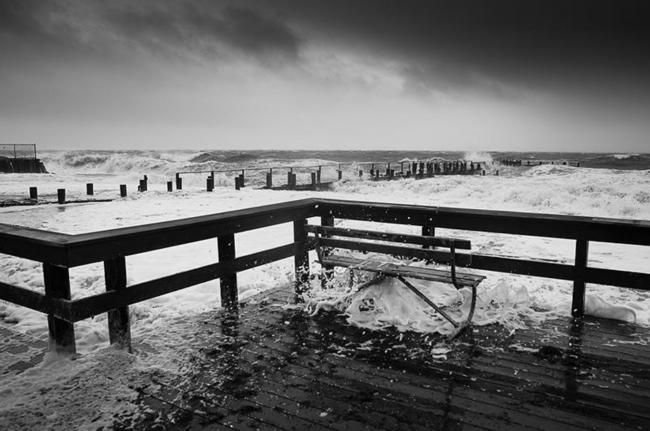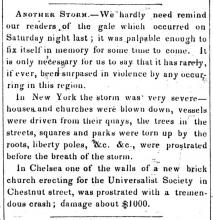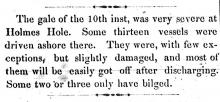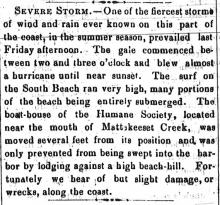On Oct. 19, 1991, 11 days before a piece of “the perfect storm” hit Martha’s Vineyard, three people left the Menemsha harbor on their way to the Bermuda. Nine days later, 100 miles from their destination, the three abandoned their sinking sailboat and all of their belongings to climb aboard a mammoth British container vessel that hours before had picked up their faint mayday call.
Aboard the 31-foot fiberglass sailboat, Cygnus (named after the swan constellation), were Kate Decarvalho, Charlie Belden, and Marc Hammarlund. Though Mrs. Decarvalho had been sailing, this trip was to be her first offshore experience. Mr. Hammarlund and Mr. Belden were both experienced sailors, and Mr. Belden had made the trip to Bermuda several times.
The three were making the trip at the tail end of hurricane season and had been checking the weather forecasts regularly for a window of time to make what is usually a five-day trip down the coast to Bermuda. They thought they had found it at the end of October.
“It looked great,” said Mrs. Decarvalho, who grew up on the Island and now lives in Providence.
“A beautiful shot of weather,” agreed Mr. Belden, who grew up spending summers on the Island and now lives in South Carolina. Mr. Hammarlund still lives on the Island but has been unavailable for comment.
The first attempt to make the trip was aborted during the second night, when the wind nearly stopped. With the lack of wind slowing their progress, and word of a small storm stirring up in the gulf stream, the three turned back after traveling what Mrs. Decarvalho estimated was 150 miles.
Eight hours later, the weather was back to normal and the crew decided to try again.
After the trip, with a little help from Mr. Belden, Mrs. Decarvalho wrote an account of what happened. She had wanted to keep a journal during the trek, but was seasick most of the time. She referred to her written account in a telephone interview from her home in Providence .
Her sickness, she said, blended the days together in a dreamlike hallucination. Once while standing watch, she saw what she thought was a particularly bright star in the sky; it turned out to be ship coming towards the sailboat.
The weather on the fourth night of the journey grew relaxed and gentle, but the next morning, the wind turned heavy and the water choppy. Mrs. Decarvalho was inside the boat making lunch when she heard a yelp. Mr. Belden was on the deck when a cormorant, a shore bird, landed on his head. The exhausted bird rested elsewhere on the ship for several hours before flying away.
“We’d obviously been caught up in the storm and been pulled towards land,” Mrs. Decarvalho said. “Over the next three days I realized our prospects were not looking good.”
On the fifth day, the storm caught the Cygnus.
“The crash of the waves against the hull made it sound as though we were in a big drum,” Mrs. Decarvalho read from her account. “And with each wave that landed in the cockpit, my adrenalin prepared me in case I didn’t hear a response to my call of ‘Are you still there?’ to the man on watch.”
The seas were so rough at this point that retrieval of a man overboard would have been nearly impossible, said Mrs. Decarvalho. “We didn’t have control over the boat.”
On the sixth day, all sails were taken down except for the small storm jib and the crew set the sea anchor, a parachute-shaped piece of fabric designed to slow and steady the boat as it is dragged through the water. Both were torn out the following day by the worsening weather.
The crew used milk crates and an empty bucket as a makeshift sea anchor to steady the boat. “Anything we had,” Mrs. Decarvalho said.
The washboard closing the main hatch flew off the same day, and although the three tried to plug the hatch with a square bag of life preservers, seawater continued to leak into the boat. The crew also found that the engine, which charges the batteries that power the nautical instruments, would no longer start.
By this time, the boat was caught in 40 foot seas, riding up and down waves 10 feet longer than itself. “It felt like we were going over the sides of mountains and down,” Mrs. Decarvalho said. “It was that intense.”
The seventh day also brought an erroneous forecast that the storm was clearing, which temporarily lifted the crew’s spirits. The next day, however, the weather report changed, informing the crew of two things: a tropical storm was quickly moving south towards them, and reconnaissance planes had been deployed to see if the storm was turning into a hurricane. It would soon be named Hurricane Grace, which would travel up the East Coast to join two other storm fronts and become the 100-Year Storm, the subject of the book and movie, The Perfect Storm.
It hit the Cygnus a day later.
Mr. Belden and Mrs. Decarvalho agree this was the point Ð when they heard the eerie, computerized weather report through their failing radio Ð that they realized they were in trouble. Yet both use the same word when they remember the water that day: “Beautiful.”
“We were definitely in the gulf stream,” said Mr. Belden. “During the storm I remember how beautiful it was.”
Mrs. Decarvalho read from her account: “It was beautiful. Translucent turquoise caps curled against the steel-gray sky.”
The next two days melted together for Mrs. Decarvalho, who by then was hallucinating heavily from exhaustion, sea sickness and lack of sleep. She remembers being too terrified to go out on the deck alone but enchanted by the weather and ocean.
“I was losing it,” she says.
On the eighth day the crew began to radio for help, though no one had seen a ship in days. Waves were now breaking over the boat and wind was approaching 60 miles per hour. Hurricane force winds start at 74 miles per hour.
On the morning of the ninth day, when their boat climbed to the peak of the sea’s 40-foot waves, the crew could see a ship in the distance. The ship grew closer, and until the large boat passed them in the distance, the crew thought they had been spotted. As the boat moved away, however, the crew made radio contact with what they soon realized was a different boat.
They were soon talking to Captain Joop Vrolyk, an employee of the British Container Alliance in charge of bringing the giant CMV Oleander from Port Elizabeth, N.J., to Hamilton, Bermuda.
He informed the three Vineyarders that they were 100 miles from the coast of Bermuda, and would be hit by the northeast quadrant of a hurricane in about 12 hours if they stayed in place.
After a brief discussion and subsequent rejection of a towing possibility, the crew decided to abandon their boat and board the Oleander.
“Against our boat, she looked like a skyscraper laid flat against a VW bug,” Mrs. Decarvalho read. She estimated the Oleander was about 450 long and five stories high. “It was high,” she said. “The guys up above looked small.”
She titled her account of boarding the ship, “The Most Dangerous Part Of Our Journey.”
Because the wooden-runged, two-foot-wide rope ladder on board the Oleander only reached halfway to the water, the crew hung cargo netting down to the water and threw the ladder on top of that. The sailboat crew would have to climb halfway up the boat on the netting and the rest of the way on the ladder.
In the giant waves, the Oleander was pitching and rolling, leaning from side to side while the bow and stern reared up and down, at times lifting the stern of the ship out of the water.
As the Oleander pulled up next to the leaking sailboat, Mrs. Decarvalho looked back and saw the ship’s giant propeller lift out of the water. She also noticed the Cygnus was drifting towards the Oleander’s stern.
Mr. Hammarlund. broke his last chocolate bar into three pieces, the crew ate what they hoped would give them a rush of energy, and Mr. Belden jumped into the water.
Almost immediately after that, the Oleander’s stern reared up and came down on the stern of the sailboat, five feet from Mrs. Decarvalho.
“Everybody in the water, NOW,” Mr. Belden screamed from the netting after he saw what had happened.
The first thing Mrs. Decarvalho noticed when she hit the water was its warmness. Next was the suction the Oleander’s rolling had created. Mr. Belden held the net with one hand and grabbed Mrs. Decarvalho with the other, pulling her to the netting. Mr. Hammarlund was holding the netting near Mrs. Decarvalho’s feet.
Mrs. Decarvalho grabbed the netting, and was instantly jerked out of the water as the huge boat rocked to the other side. She estimated being 20 feet out of the water before the boat’s momentum ceased and began moving the other way, submerging all three of the crew for what Mrs. Decarvalho originally wrote was 15 seconds but now thinks was much longer.
It was underwater that the threat of death became real for the first time for Mrs. Decarvalho. “I hadn’t felt that way before. I had always thought, ‘We can make it,’ but I was so weak and hungry,” she said.
When the three emerged from the water, they were closer to the ladder with Mr. Belden actually standing on it. He was trying to pull Mrs. Decarvalho upwards. Both heard the crew shouting, “Lady first,” before they were submerged again.
Weak from vomiting and three days without sleep, when Mrs. Decarvalho reached the surface again, she knew she was running out of energy and had to climb the ladder then or not at all. Now hanging from the first rung as if she were preparing to do a chin-up, and after being dunked a third time, she summoned all her strength and lifted her right leg above her head onto the first rung of the ladder. She flew up the ladder “like a particle in a gust of wind” and as she reached the top, the boat began to rock towards her, swinging the ladder out into the air just as the arms of the men on board the Oleander pulled her, shaking from adrenaline, onto the deck.
Mr. Belden was close behind her, followed by Mr. Hammarlund. Soon after they were aboard they were brought to the bridge, where they met Captain Vrolyk. With all three of them in a state of shock, the dark bridge with its many glowing lights and meters made the experience even more surreal.
Captain Vrolyk gestured out the window to the left, where the three could see their smashed boat still carrying their money, passports and clothes, starting to sink.
After giving the three showers, food and dry clothes, the Oleander’s crew joked with them, calling their boat “Tupperware.” The three stayed for a few days on the boat when it docked in Bermuda and rode back to New Jersey with them a few days later.
Crew members also told the crew of three from Martha’s Vineyard that they never expected them to make it to the top of the ladder. As moviegoers this month will realize, not every mariner survived this storm.




 2 comments
2 comments





Comments (2)
Comments